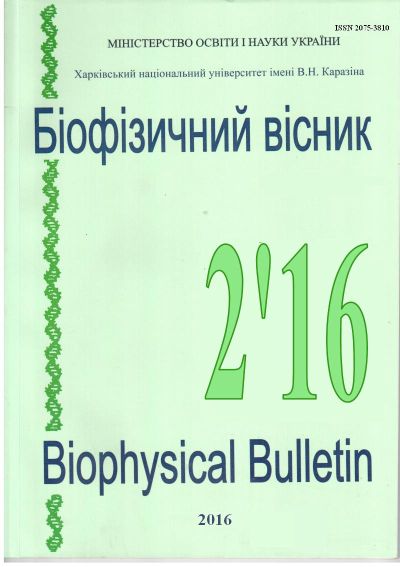Theoretical analysis of amyloidogenic potential of lysozyme, cytochrome C and apolipoprotein A-I
Abstract
Using 8 web-algorithms, including Pasta2, AmylPred2, Tango, MetAmyl, Waltz, Aggrescan, BetaScan та FoldAmyloid, theoretical analysis of amino acid sequences of lysozyme, cytochrome c and N-terminal fragment of apolipoprotein A-I has been carried out, and amyloidogenic fragments of the proteins have been identified. The fragment was identified as amyloidogenic if it was determined by at least four algorithms. Comparative analysis of aggregation-prone regions of native and mutant proteins showed that that all mutants are characterized by same amyloidogenic segments as native proteins with the amyloidogenic potential being more pronounced for mutated proteins. It was shown that aggregation-prone regions of all proteins analyzed here, were rich in hydrophobic aliphatic (Ile, Val, Leu, Ala) and aromatic (Trp, Phe, Tyr) amino acid residues. Hydrophobic interactions were supposed to play key role in protein aggregation process.
Downloads
References
2. Volpatti L, Knowles T. Polymer physics inspired approaches for the study of the mechanical properties of amyloid fibrils. J. Polymer Sci. A. 2014;52:281-92.
3. Adamcik J, Mezzenga R. Protein fibrils from a polymer physics perspective. Macromolecules. 2012;45:1137-50.
4. Tycko R. Solid state NMR studies of amyloid fibril structure. Annu. Rev. Phys. Chem. 2011;62:279-99.
5. Sunde M, Serpell LC, Bartlam M, Fraser PE, Pepys MB, Blake CC. Common core structure of amyloid fibrils by synchrotron X-ray diffraction. J. Mol. Biol. 1997;273:729-39.
6. Wagoner VA, Cheon M, Chang I, Hall CK. Impact of sequence on the molecular assembly of short amyloid peptides. Proteins. 2014;82:1469-83.
7. Garbuzynskiy S, Lobanov M, Galzitskaya O. FoldAmyloid: a method of prediction of amyloidogenic regions from protein sequence. Bioinformatics. 2010;26:326-32.
8. Fernandez-Escamilla AM, Rousseau F, Schymkowitz J, Serrano L. Prediction of sequence-dependent and mutational effects on the aggregation of peptides and proteins. Nat. Biotechnol. 2004;22:1302-6.
9. Maurer-Stroh S, Debulpaep M, Kuemmerer N, Lopez de la Paz M, Martins IC, Reumers J et al. Exploring the sequence determinants of amyloid structure using position-specific scoring matrices. Nat. Methods. 2010;7:237-42.
10. Tsolis AC, Papandreou NC, Iconomidou VA, Hamodrakas SJ. A consensus method for the prediction of “aggregation-prone” peptides in globular proteins. PLoS One. 2013;8:e54175.
11. Emily M, Talvas A, Delamarche C. MetAmyl: a META-predictior of AMYLoid proteins. PLoS One. 2013;8:e79722.
12. Walsh I, Seno F, Tosatto SC, Trovato A. PASTA2: an improved server for protein aggregation prediction. Nucl. Acids Res. 2014;42:W301-7.
13. Bryan AW Jr, Menke M, Cowen LJ, Lindquist SL, Berger B. BETASCAN: probable beta-amyloids identified by pairwise probabilistic analysis. PLoS Comput. Biol. 2009;5:1000333.
14. Conchillo-Solé O, de Groot NS, Avilés FX, Vendrell J, Daura X, Ventura S. AGGRESCAN: a server for the prediction and evaluation of “hot spots” of aggregation in polypeptides. BMC Bioinformatics. 2007;8:65.
15. Frare E, Mossuto MF, Polverino de Laureto P, Dumoulin M, Dobson CM, Fontana A. Identification of the core structure of lysozyme amyloid fibrils by proteolysis. J. Mol. Biol. 2006;361:551-61.
16. Das M, Gursky O. Amyloid-forming properties of human apolipoproteins: sequence analysis and structural insights. Springer Subcellular Biochemistry Series: Lipids in Protein Misfolding 2015;855:175-211.
17. Calamai M, Taddei N, Stefani M, Ramponi G, Chiti F. Relative influence of hydrophobiсity and net charge in the aggregation of two homologous proteins. Biochemistry. 2003;42:15078-83.
18. Tu L, Raleigh D. Role of aromatic interactions in amyloid formation by islet amyloid polypeptide. Biochemistry. 2013;52:333-42.
19. Marek P, Abedini A, Song B, Kanungo M, Johnson ME, Gupta R et al. Aromatic interactions are not required for amyloid fibril formation by islet amyloid polypeptide but do influence the rate of fibril formation and fibril morphology. Biochemistry. 2007;46:3255-61.
20. Gazit E. Self-assembly of short aromatic peptides into amyloid fibrils and related nanostructures. Prion. 2007;1:32-5.
Authors who publish with this journal agree to the following terms:
- Authors retain copyright and grant the journal right of first publication with the work simultaneously licensed under a Creative Commons Attribution License that allows others to share the work with an acknowledgement of the work's authorship and initial publication in this journal.
- Authors are able to enter into separate, additional contractual arrangements for the non-exclusive distribution of the journal's published version of the work (e.g., post it to an institutional repository or publish it in a book), with an acknowledgement of its initial publication in this journal.
- Authors are permitted and encouraged to post their work online (e.g., in institutional repositories or on their website) prior to and during the submission process, as it can lead to productive exchanges, as well as earlier and greater citation of published work (See The Effect of Open Access).





